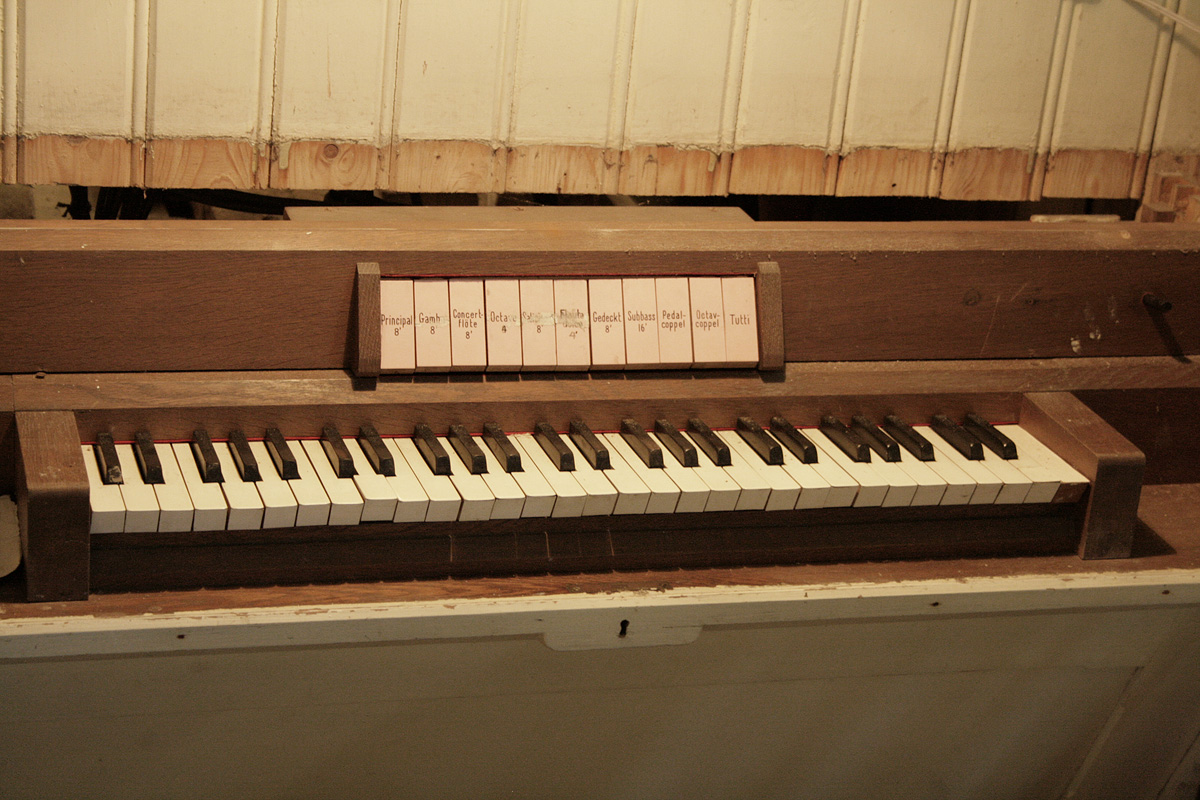Code, Codes luterāņu kapi
| Builder | Anonymous |
|---|---|
| Year | ca. 1924 |
| Period/Style | Romantic |
| Stops | 8 |
| Keyboards | 1+P |
| Keyaction | pneumatic |
| Tuning | Equal |
The organ, built in 1924, is a single-manual instrument with a pneumatic action and pedal, constructed using factory parts. It has suffered greatly from pipe theft and high humidity. Currently, it is not in playable condition. Optimizing the climate within the church would be the main prerequisite for the potential restoration of the instrument.
The large inscription on the back of the organ case reveals the date of its consecration: "Iesvetitas 1924 31/VIII" (Consecrated on August 31, 1924). The organ builder is currently unknown, but it is speculated that it might have been Kaspars Skerstens.
Two inscriptions on the cover above the pedal keyboard indicate the early impact of the church's climate on the instrument's functionality:
"Repariert u. gestimmt 7. u. 8. Juni 1927. Das Werk hat durch zu große Feuchtigkeit stark gelitten! H.Kolbe i/Fa Rigaer Orgelbau-Vereinigung" (Repaired and tuned on June 7 and 8, 1927. The instrument suffered greatly from excessive humidity! H. Kolbe, Riga Organ Builders Association).
"Remontētas un skaņotas 1927.g. 7. un 8. jūnijā. Instruments cietis no pārāk liela mitruma. H.Kolbe, Rīgas ērģeļbūves apvienība" (Repaired and tuned on June 7 and 8, 1927. The instrument suffered from too much humidity. H. Kolbe, Riga Organ Builders Association).
"Repariert, neue Membranen gelegt und gereinigt in Mai 1931. A.Krans" (Repaired, new membranes installed, and cleaned in May 1931. A. Krans).
"Remontētas, mainītas membrānas, tīrītas 1931.g. maijā. A.Krāns" (Repaired, membranes replaced, cleaned in May 1931. A. Krāns).
Thus, only a few years after the organ was built, it had already suffered significant damage due to high humidity levels.
The large inscription on the back of the organ case reveals the date of its consecration: "Iesvetitas 1924 31/VIII" (Consecrated on August 31, 1924). The organ builder is currently unknown, but it is speculated that it might have been Kaspars Skerstens.
Two inscriptions on the cover above the pedal keyboard indicate the early impact of the church's climate on the instrument's functionality:
"Repariert u. gestimmt 7. u. 8. Juni 1927. Das Werk hat durch zu große Feuchtigkeit stark gelitten! H.Kolbe i/Fa Rigaer Orgelbau-Vereinigung" (Repaired and tuned on June 7 and 8, 1927. The instrument suffered greatly from excessive humidity! H. Kolbe, Riga Organ Builders Association).
"Remontētas un skaņotas 1927.g. 7. un 8. jūnijā. Instruments cietis no pārāk liela mitruma. H.Kolbe, Rīgas ērģeļbūves apvienība" (Repaired and tuned on June 7 and 8, 1927. The instrument suffered from too much humidity. H. Kolbe, Riga Organ Builders Association).
"Repariert, neue Membranen gelegt und gereinigt in Mai 1931. A.Krans" (Repaired, new membranes installed, and cleaned in May 1931. A. Krans).
"Remontētas, mainītas membrānas, tīrītas 1931.g. maijā. A.Krāns" (Repaired, membranes replaced, cleaned in May 1931. A. Krāns).
Thus, only a few years after the organ was built, it had already suffered significant damage due to high humidity levels.
| Manual | Pedal |
|---|---|
| Principal 8' | Subbass 16' |
| Gamba 8' | |
| Concertflöte 8' | |
| Salicional 8' | |
| Gedeckt 8' | |
| Octave 4' | |
| Flaute dolce 4' |
No Video/Audio samples available.
https://orgcat.lv/code_main.htm
 Pipe Organ Map
Pipe Organ Map

